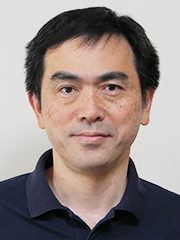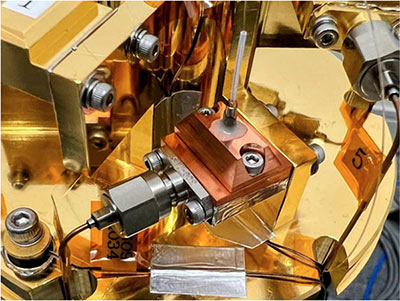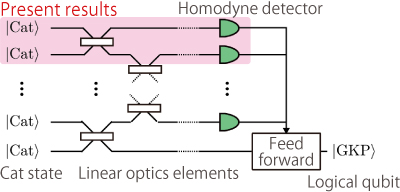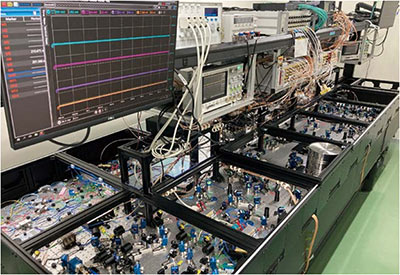Research Results
A Major Step Toward Realizing Fault-Tolerant Universal Optical Quantum Computers
Generation of GKP Logical Qubits with Propagating Light for Fault ToleranceFY2025

- FURUSAWA Akira (Professor, School of Engineering, the University of Tokyo, Deputy Director of RIKEN Center for Quantum Computing)
- Moonshot Research and Development Program
- Moonshot Goal 6: Realization of a fault-tolerant universal quantum computer that will revolutionize economy, industry, and security by 2050
Project Manager (2020-2025), "Development of large-scale fault-tolerant universal optical quantum computers"
World's First Optical Generation of Gottesman-Kitaev-Preskill Qubits
A research group represented by Professor Akira Furusawa, Professor at the School of Engineering, The University of Tokyo and Deputy Director of the RIKEN Center for Quantum Computing is working on the development and practical application of an optical fault-tolerant large-scale quantum computer*1. As part of this effort, the research group announced in January 2024 that it produced the world's first Gottesman-Kitaev-Preskill (GKP) qubit*2 as a propagating light-based logical qubit*3.
One issue in the properties of quantum computers is that they are prone to errors (calculation errors). Classical computers have the ability to "correct" errors, but quantum computers, in principle, struggle to "correct." Therefore, the focus has been on fault-tolerant quantum computers, which have the "tolerance" to handle any errors that occur. Although the GKP qubit is considered to be a promising logical qubit that enables such tolerance, it has not yet been realized optically.
The research group successfully produced optical GKP qubits using a superconducting photon detector (Fig. 1) jointly developed by The University of Tokyo and the National Institute of Information and Communications Technology (NICT). This GKP qubit is compatible with the large-scale optical quantum processor (arithmetic device) developed by the research group and may lead to realizing fault tolerance functions in large-scale fault-tolerant optical quantum computers.
*1 Fault-tolerant quantum computer
In quantum computers, the accumulation of errors caused in the process of quantum calculation often diminishes the reliability of information. The fault-tolerant quantum computer is capable of operating in a manner that corrects the final quantum calculation result even in the presence of such errors.
*2 GKP qubit
While conventional methods use a considerable number of qubits to constitute one logical qubit, the Gottesman-Kitaev-Preskill (GKP) qubit uses a single optical pulse to realize one logical qubit. This enables large-scale and high-speed optical quantum computers.
*3 Logical qubit
The qubit is the fundamental element in quantum information processing. While current computers are based on bits that use "0" or "1" values, qubits can use a superposition of "0" and "1" values, enabling information processing that current computers cannot perform. However, if errors occur due to electromagnetic waves, heat, or other noises, the quantum information cannot be retained. This is prevented by logical qubits, which arrive at the correct calculation result by detecting and eliminating errors that begin to accumulate during the calculation process while retaining the superposition of "0" and "1."

Fig.1 Superconducting photon detector jointly developed by The University of Tokyo and National Institute of Information and Communications Technology
GKP qubit as a key to the development of fault-tolerant quantum computers
To meet the demands of advanced information processing such as AI usage, further high-capacity and high-speed computers are needed. As the advancement of current computers reaches the limit, there is growing anticipation for quantum computers. Quantum computers include superconducting, semiconducting, ion trap, cold atom, and optical methods.
One of the major challenges for all forms of quantum computers is ensuring the reliability of the calculation results. Current computers are highly reliable because they have "error correction functions" that detect errors in calculations and recalculates them. By contrast, quantum computers handle quantum information that is susceptible to errors due to the effects of electromagnetic waves and heat and is difficult to implement error correction mechanisms. Therefore, there is a need for "fault tolerance," which can overcome any errors that occur and obtain correct calculation results. This role can be fulfilled by logical qubits, which detect and eliminate errors that begin to accumulate in the calculation process. Conventionally, the focus was on composing a single logical qubit using numerous qubits. However, this method requires an immense number of qubits, posing the largest obstacle in realizing practical quantum computers. Garnering attention as a method to overcome this problem is the GKP qubit, which enables one logical qubit with a single qubit.
Generating a GKP state using the newly developed photon detector
The research group is researching optical quantum computers and has successfully verified in 2019 a quantum computing platform that can achieve any quantum operation on a large scale. This verified that the properties of the light propagation wave-based quantum system*4 lead to expanding the scale and ease in mutual interaction. Incorporation of logical qubits that are equipped with sufficient "fault tolerance" will enable practical fault-tolerant optical quantum computers.
The GKP qubit, which can realize one logical qubit with a single optical pulse, has been considered a promising candidate for the logical qubit. Strong nonlinearity*5 is required to realize the structure of GKP qubits. However, unlike standing waves (stationary systems) such as superconductors and ion traps, light propagation waves face difficulties in amplification of nonlinearity, and the realization of GKP logic qubits in optical quantum computers was one of the major challenges.
The research group therefore used a superconducting photon detector (Fig. 1) that was jointly developed by The University of Tokyo and NICT and successfully generated a GKP state with light (Fig. 2). In the generation method, the "Schrödinger's cat state"*6 was first generated. Although this Schrodinger's cat state is a highly quantum state, its structure differs from the GKP state. Therefore, the structure was altered using linear optical elements. This resulted in the peak structure shown in Fig. 3. The number and sharpness of the peaks characterize the quality of the GKP state.
The structure was altered in one step in the present research. However, the strength of this method is the ability to realize a high-quality GKP state by repeating the same method to increase the number of peaks and its future scalability is anticipated.
*4 Propagating wave quantum system
Various systems that allow quantum information processing can be divided into standing waves (stationary systems) and propagating waves. Typical examples of standing waves include superconductors and ion traps, and typical example of propagating waves is light. In a standing wave system, the qubits themselves are stationary, allowing easy implementation of its control, operation, and nonlinear operation. However, the systems require arranging qubits in the space and therefore entail many issues such as wiring, coupling, and expansion in scale. On the other hand, while propagating waves are suitable for quantum communications and large-scale networks owing to their propagating attribute, their operation and nonlinear operations need to be worked on.
*5 Nonlinearity
Operations in quantum computation include linear and nonlinear operations. They are classified into linearity (proportional or additive) and nonlinearity (e.g., multiplicative) with respect to the physical quantity they act on. Roughly speaking, standing wave systems can enhance systems with strong nonlinearity and nonlinearity with its standing waves but often demonstrate weakness in linear operation. Meanwhile, while light propagating waves enable linear operation with existing optical elements and therefore enable expansion in scale, they require the implementation of nonlinearity necessary to generate logical qubits since they have hardly any nonlinearity.
*6 Schrodinger's cat state
A quantum state named after the famous Schrodinger's thought experiment (the inability to learn if a cat in a box is alive or dead until one opens the box). In the optical field, the two classical lights in different phases are described with the analogy of a living cat and a dead cat, and their superposition is called Schrodinger's cat state. Schrodinger's cat state is characterized by interference fringes due to quantum interference as well as a very high quantum nature, but its structure is different from the GKP qubit.

Fig.2 Conceptual Diagram of the Experimental System

Fig.3 Observation of the Distribution Structure of the Electromagnetic Field for Error Correction Generated
Toward realizing fault-tolerant, universal optical quantum computers by 2050
In research on optical quantum computers, the focus has been on the expansion in scale and speed. The present results have enabled us to embark on a path toward realizing an ultra-high speed, large-scale, fault-tolerant optical quantum computer.
It was announced in November 2024 that the rate of generating optical quantum states in a strong quantum state was successfully enhanced to a speed 1000 times faster than that of conventional systems. As such, research aimed at social implementation of optical quantum computers through the development of groundbreaking fundamental technologies is advancing (Fig. 4).
Based on the results to date, OptQC Corp. was established in September 2024. The company plans to offer commercial devices in FY 2026.

Fig.4
Universal Optical Quantum Computer Developed by the Research Team
